A la "naissance" de Tintin,
Georges Remi avait à peine vingt un ans. Il signait déjà Hergé depuis des
années. En effet, au cours de ses études au Collège, il s’était distingué
comme illustrateur et avait publié ses premiers dessins dans une revue scoute.
Employé au Service des abonnements d’un quotidien belge catholique,
Le Vingtième Siècle, et caressant le secret espoir d’y devenir un jour
grand reporter, il s’y était fait remarquer par ses qualités de dessinateur.
Le directeur du journal lui avait confié la responsabilité d’un supplément
hebdomadaire pour les jeunes: Le Petit Vingtième. Hergé, qui y
faisait tout ou presque tout, avait entrepris d’illustrer une histoire dont
le scénario sans queue ni tête lui avait été imposé. C’est de la lassitude
pour cette tâche sans intérêt qu’est né Tintin. Non content d’avoir créé
un héros bien à lui, le jeune Hergé, qui avait lu les "comics" américains,
voulait aussi innover en matière graphique, en faisant s ’exprimer les personnages
au moyen de phylactères plutôt que dans un texte au bas des cases.
Nous sommes le 10 janvier 1929, à Bruxelles. Accompagné de son chien Milou,
un tout jeune reporter monte dans le train à destination de Mouscou. Pour
Tintin, c’est le début d’une grande aventure. Pour Hergé, c’est le vrai
début de sa carrière. Les Aventures de Tintin, reporter du Petit
Vingtième au pays des Soviets paraîtront sous forme d'album en
1930. Cette année marque la naissance d’un mythe qui n’est pas près de s’éteindre,
et les premiers signes d’une troublante confrontation entre la fiction et
la réalité. Ainsi, quand sa première aventure se termine, lorsque Tintin
est censé rentrer chez lui, à Bruxelles, une foule nombreuse et bien réelle
vient accueillir à la gare du Nord le héros de papier, à son retour d’URSS
! C’est l’amorce d’un succès de masse qui ne cessera de s’amplifier au fil
du temps. Sûr de sa popularité, Tintin repart aussitôt, et pour l’Afrique
cette fois. Les Aventures de Tintin, reporter du Petit Vingtième
au Congo (1931) est le reflet d’une époque coloniale et paternaliste.
Pour ces nouvelles aventures, Hergé improvise encore le récit, mais plus
pour longtemps. Dans Tintin en Amérique (1932), le héros confirme
sa vocation de redresseur de torts, en s’opposant à mafioso Al Capone, aux
gangsters de Chicago et aux fripouilles de tout acabit. Déjà, Hergé témoigne
d’une vision généreuse du monde, stigmatisant par exemple des Blancs envers
les Indiens Peaux-Rouges. Dans Les Cigares du Pharaon (1934),
Tintin se trouve impliqué, par hasard et malgré lui, dans un trafic de stupéfiants
qui va l’entraîner jusqu’en Inde. Entre-temps, il aura rencontré Dupond
et Dupont, deux policiers balourds dont les rôles vont s’affirmer progressivement.
Poursuivant les trafiquants jusqu’en Chine, Tintin fera, dans Le
Lotus Bleu (1936), la connaissance de Tchang, un jeune Chinois qui
lui fera perdre ses derniers préjugés. En Rastatopoulos il se découvrira
par contre un redoutable ennemi qu’il retrouvera d’ailleurs plus tard...
Hergé, dont la technique narrative et graphique ne cesse de s’affirmer,
accorde désormais une importance essentielle au scénario et à la documentation.
Son souci de véracité se confirme à tous les niveaux, et c’est sans complaisance
qu’il juge la politique expansionniste du Japon dans le conflit qui l’oppose
alors à la Chine. L’Oreille Cassée (1937) est une course poursuite
palpitante. Tintin s’embarque pour l’Amérique du Sud afin de récupérer un
fétiche volé. Là-bas s’opposent toutes sortes d’intérêts : militaires, économiques,
la guerre du Gran Chaco venait d’opposer, trois ans durant, la Bolivie et
le Paraguay. 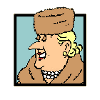 Hergé
trouve dans l’actualité du temps d’autres thèmes intéressants. La presse
fait alors état d’un trafic de fausse monnaie, et c’est l’Ile Noire
(1938). Tintin file en Ecosse, où un gorille hante un manoir isolé sur une
île rocheuse. Pays imaginaire, la Syldavie sert de décor à l’épisode
suivant : Le Sceptre d’Ottokar (1939). C’est dans ce petit royaume
d’Europe orientale que Tintin fera la connaissance de la pittoresque Bianca
Castafiore, avant de voler au secours de la monarchie syldave, déjouant
un complot qui n’est pas sans allusion à l’Anschluss et à la Seconde Guerre
mondiale qui s’annonce. Les contraintes de l’occupation allemande en
Belgique (1940) et la menace de la censure de la presse conduisent Hergé
à prendre ses distances vis — vis de l’actualité et à approfondir
son univers propre loin des angoisses et des vicissitudes de la guerre.
Le Crabe aux pinces d’Or (1941) renoue avec l’aventure exotique.
Celle-ci mène Tintin en Afrique du Nord. Il y déjoue les plans d’une bande
de malfaiteurs qui dissimulaient de l’opium dans des boîtes de crabe. C’est
à la faveur de ce récit que Tintin fait la rencontre inopinée de celui qui
deviendra son principal compagnon d’aventures : le capitaine Haddock. Premier
épisode à paraître en couleurs, L’Etoile mystérieuse (1942) se
fonde sur la chute, dans les régions arctiques, d’un aérolithe qui contiendrait
un métal inconnu. Tintin et Haddock font partie de l’expédition scientifique
qui, aux prix d’une hallucinante course contre la montre avec des financiers
sans scrupules, tente de la récupérer. Dans Le Secret de la Licorne
(1943) et Le Trésor de Racham le Rouge (1944) qui en est la suite,
Tintin accompagne le capitaine Haddock sur les traces de son glorieux ancêtre,
le chevalier François de Hadoque. Inventeur d’un sous-marin de poche en
forme de requin, un certain Tryphon Tournesol contribue à la découverte
du trésor, avant d’offrir au Capitaine le château de ses aïeux : Moulinsart.
Dans Les Sept Boules de cristal (1948), sept savants sont
mystérieusement frappés de léthargie à leur retour d’expédition dans les
Andes. Le professeur Tournesol ayant disparu, Tintin et le Capitaine partent
à sa recherche. C’est au Pérou, dans l’épisode intitulé Le Temple
du Soleil (1949) qui conclut cette aventure, qu’ils le retrouveront,
prisonnier des derniers Incas. Ensemble, ils parviendront à délivrer les
victimes de la malédiction qui les paralysait. Partout dans le monde,
des moteurs d’autos explosent : l’essence doit être trafiquée! Une crise
pétrolière menace. Au Moyen Orient, le cheik Bab El Ehr tente de renverser
Ben Kalish Ezab, et ce conflit local peut dégénérer en une guerre générale.
C’est bien assez pour inciter Tintin à se rendre, toutes affaires cessantes,
Au Pays de l’Or noir (1950). Objectif Lune (1953)
détaille les prémices et les préparations de l’expédition lunaire que compte
entreprendre le professeur Tournesol au départ du sol syldave. On
a marché sur la Lune (1954) décrit le premier voyage spatial et l’exploration
de notre satellite par Tintin et ses compagnons, quinze ans avant l’Américain
Armstrong! Une anticipation remarquablement documentée et époustouflante
par l’acuité visionnaire du récit. L’Affaire Tournesol (1956)
, ou "comment la science peut oeuvrer sans être convoitée par les militaires":
dans le climat tendu de la guerre froide, cette nouvelle aventure entraîne
à nouveau Tintin en Syldavie et en Bordurie. Inventeur d’un dispositif à
ultra-sons, le professeur a été enlevé. Un courtier en assurances, qui s’avérera
être un casse-pieds invétéré, en a profité pour faire son apparition dans
l’aventure : Séraphin Lampion. Course poursuite, rebondissements, retrouvailles,
fuite éperdue... dont l’enjeu semble être un banal parapluie : c’est sans
doute aussi l’épisode le plus policier de la série. Dans l’album Coke
en stock (1958), le lecteur apprend que le trafic d’esclaves existe
encore. Au terme d’un périple au large des Emirats arabes et à l’issue d’un
impressionnant combat naval, Tintin parviendra à démanteler l’odieux commerce
clandestin organisé par le sinistre Rastatopoulos. Un avion de ligne
à bord duquel le jeune Chinois Tchang se rendait en Europe s’est écrasé
dans l’Himalaya. Tintin au Tibet (1960), pure histoire d’amitié,
sans le moindre méchant, décrit la recherche désespérée à laquelle Tintin
se livre pour retrouver son ami. Ce récit pathétique, qui rompt avec le
ton extraverti des épisodes précédents, démontre que la fidélité et l’espoir
sont capables de vaincre tous les obstacles, et que les préjugés —
en l’occurrence, à l’égard de l’"abominable homme des neiges" — sont
bien souvent le fruit de l’ignorance. Dans Les Bijoux de la Castafiore
(1963), les principaux protagonistes de la série se retrouvent à Moulinsart
pour y vivre une véritable comédie classique à huis clos. Tournant résolument
le dos à l’aventure pour s’attache à la difficulté de la communication entre
les êtres, un "anti-récit" truffé de malentendus et de quiproquos plus cocasses
les uns que les autres. Vol 714 pour Sydney (1968) , c’est
le voyage interrompu, le détournement qui bouleverse tout, l’incursion de
Tintin et de ses compagnons dans l’inconnu, dans un monde irréel animé par
des phénomènes télépathiques, c’est le contact incroyable avec des extra-terrestres
et la sortie d’un rêve... Mais en est-ce bien un ? Nombre histoire
de vengeance avec prise d’otages sur fond de guérilla, Tintin et les
Picaros (1976) marque le retour de Tintin au San Theodoros, le pays
de l’Oreille Cassée . Hergé y risque un constat doux amer, tendant à faire
croire que tout en ce monde n’est que mascarade. Resté inachevé à la
mort d’Hergé, en 1983, Tintin et l’Alph-Art (1986) devait décrire
les milieux des sectes, et amener Tintin à s’immiscer dans un monde qu’affectionnait
Georges Remi, dit Hergé : celui de l’art contemporain, celui de l’avant-garde...
Si cet album posthume ne peut qu’évoquer la trame de ce récit suspendu,
il est en revanche le témoignage de l’état pur de l’extraordinaire talent
narratif et graphique du père de Tintin. Comme cette aventure, comme Tintin,
nous aussi, lecteurs, nous restons magiquement suspendus à la plume d’Hergé. Hergé
trouve dans l’actualité du temps d’autres thèmes intéressants. La presse
fait alors état d’un trafic de fausse monnaie, et c’est l’Ile Noire
(1938). Tintin file en Ecosse, où un gorille hante un manoir isolé sur une
île rocheuse. Pays imaginaire, la Syldavie sert de décor à l’épisode
suivant : Le Sceptre d’Ottokar (1939). C’est dans ce petit royaume
d’Europe orientale que Tintin fera la connaissance de la pittoresque Bianca
Castafiore, avant de voler au secours de la monarchie syldave, déjouant
un complot qui n’est pas sans allusion à l’Anschluss et à la Seconde Guerre
mondiale qui s’annonce. Les contraintes de l’occupation allemande en
Belgique (1940) et la menace de la censure de la presse conduisent Hergé
à prendre ses distances vis — vis de l’actualité et à approfondir
son univers propre loin des angoisses et des vicissitudes de la guerre.
Le Crabe aux pinces d’Or (1941) renoue avec l’aventure exotique.
Celle-ci mène Tintin en Afrique du Nord. Il y déjoue les plans d’une bande
de malfaiteurs qui dissimulaient de l’opium dans des boîtes de crabe. C’est
à la faveur de ce récit que Tintin fait la rencontre inopinée de celui qui
deviendra son principal compagnon d’aventures : le capitaine Haddock. Premier
épisode à paraître en couleurs, L’Etoile mystérieuse (1942) se
fonde sur la chute, dans les régions arctiques, d’un aérolithe qui contiendrait
un métal inconnu. Tintin et Haddock font partie de l’expédition scientifique
qui, aux prix d’une hallucinante course contre la montre avec des financiers
sans scrupules, tente de la récupérer. Dans Le Secret de la Licorne
(1943) et Le Trésor de Racham le Rouge (1944) qui en est la suite,
Tintin accompagne le capitaine Haddock sur les traces de son glorieux ancêtre,
le chevalier François de Hadoque. Inventeur d’un sous-marin de poche en
forme de requin, un certain Tryphon Tournesol contribue à la découverte
du trésor, avant d’offrir au Capitaine le château de ses aïeux : Moulinsart.
Dans Les Sept Boules de cristal (1948), sept savants sont
mystérieusement frappés de léthargie à leur retour d’expédition dans les
Andes. Le professeur Tournesol ayant disparu, Tintin et le Capitaine partent
à sa recherche. C’est au Pérou, dans l’épisode intitulé Le Temple
du Soleil (1949) qui conclut cette aventure, qu’ils le retrouveront,
prisonnier des derniers Incas. Ensemble, ils parviendront à délivrer les
victimes de la malédiction qui les paralysait. Partout dans le monde,
des moteurs d’autos explosent : l’essence doit être trafiquée! Une crise
pétrolière menace. Au Moyen Orient, le cheik Bab El Ehr tente de renverser
Ben Kalish Ezab, et ce conflit local peut dégénérer en une guerre générale.
C’est bien assez pour inciter Tintin à se rendre, toutes affaires cessantes,
Au Pays de l’Or noir (1950). Objectif Lune (1953)
détaille les prémices et les préparations de l’expédition lunaire que compte
entreprendre le professeur Tournesol au départ du sol syldave. On
a marché sur la Lune (1954) décrit le premier voyage spatial et l’exploration
de notre satellite par Tintin et ses compagnons, quinze ans avant l’Américain
Armstrong! Une anticipation remarquablement documentée et époustouflante
par l’acuité visionnaire du récit. L’Affaire Tournesol (1956)
, ou "comment la science peut oeuvrer sans être convoitée par les militaires":
dans le climat tendu de la guerre froide, cette nouvelle aventure entraîne
à nouveau Tintin en Syldavie et en Bordurie. Inventeur d’un dispositif à
ultra-sons, le professeur a été enlevé. Un courtier en assurances, qui s’avérera
être un casse-pieds invétéré, en a profité pour faire son apparition dans
l’aventure : Séraphin Lampion. Course poursuite, rebondissements, retrouvailles,
fuite éperdue... dont l’enjeu semble être un banal parapluie : c’est sans
doute aussi l’épisode le plus policier de la série. Dans l’album Coke
en stock (1958), le lecteur apprend que le trafic d’esclaves existe
encore. Au terme d’un périple au large des Emirats arabes et à l’issue d’un
impressionnant combat naval, Tintin parviendra à démanteler l’odieux commerce
clandestin organisé par le sinistre Rastatopoulos. Un avion de ligne
à bord duquel le jeune Chinois Tchang se rendait en Europe s’est écrasé
dans l’Himalaya. Tintin au Tibet (1960), pure histoire d’amitié,
sans le moindre méchant, décrit la recherche désespérée à laquelle Tintin
se livre pour retrouver son ami. Ce récit pathétique, qui rompt avec le
ton extraverti des épisodes précédents, démontre que la fidélité et l’espoir
sont capables de vaincre tous les obstacles, et que les préjugés —
en l’occurrence, à l’égard de l’"abominable homme des neiges" — sont
bien souvent le fruit de l’ignorance. Dans Les Bijoux de la Castafiore
(1963), les principaux protagonistes de la série se retrouvent à Moulinsart
pour y vivre une véritable comédie classique à huis clos. Tournant résolument
le dos à l’aventure pour s’attache à la difficulté de la communication entre
les êtres, un "anti-récit" truffé de malentendus et de quiproquos plus cocasses
les uns que les autres. Vol 714 pour Sydney (1968) , c’est
le voyage interrompu, le détournement qui bouleverse tout, l’incursion de
Tintin et de ses compagnons dans l’inconnu, dans un monde irréel animé par
des phénomènes télépathiques, c’est le contact incroyable avec des extra-terrestres
et la sortie d’un rêve... Mais en est-ce bien un ? Nombre histoire
de vengeance avec prise d’otages sur fond de guérilla, Tintin et les
Picaros (1976) marque le retour de Tintin au San Theodoros, le pays
de l’Oreille Cassée . Hergé y risque un constat doux amer, tendant à faire
croire que tout en ce monde n’est que mascarade. Resté inachevé à la
mort d’Hergé, en 1983, Tintin et l’Alph-Art (1986) devait décrire
les milieux des sectes, et amener Tintin à s’immiscer dans un monde qu’affectionnait
Georges Remi, dit Hergé : celui de l’art contemporain, celui de l’avant-garde...
Si cet album posthume ne peut qu’évoquer la trame de ce récit suspendu,
il est en revanche le témoignage de l’état pur de l’extraordinaire talent
narratif et graphique du père de Tintin. Comme cette aventure, comme Tintin,
nous aussi, lecteurs, nous restons magiquement suspendus à la plume d’Hergé.
|
 On
a January 10:
On
a January 10: 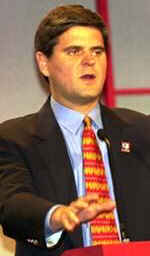 2001
The Ehime Maru school boat leaves Japan to fish tuna, swordfish
and shark. It would be sunk on 9 February by a US submarine surfacing near
Hawaii and 9 of the 35 on the school boat would drown.
2001
The Ehime Maru school boat leaves Japan to fish tuna, swordfish
and shark. It would be sunk on 9 February by a US submarine surfacing near
Hawaii and 9 of the 35 on the school boat would drown.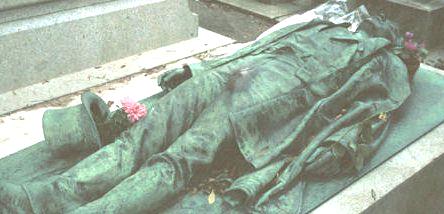
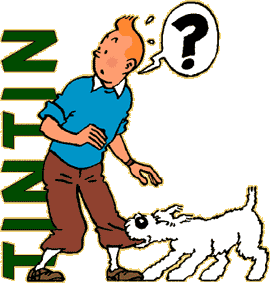
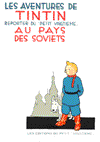 La parution d’un livre qui marque le début de la carrière internationale
d’un jeune reporter qui fera parler de lui auprès des jeunes de 7 à 77 ans.
:.
La parution d’un livre qui marque le début de la carrière internationale
d’un jeune reporter qui fera parler de lui auprès des jeunes de 7 à 77 ans.
:. 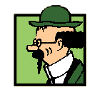 ,
image du savant sourd et distrait manifestement inspiré du professeur Picard
qui bénéficiait alors d’une certaine notoriété, le capitaine Haddock
,
image du savant sourd et distrait manifestement inspiré du professeur Picard
qui bénéficiait alors d’une certaine notoriété, le capitaine Haddock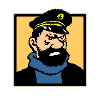 ,
très porté sur l’alcool, qui invente des jurons, le couple policier que
forment les Dupond-Dupont, dont l’un des membres reprend, en écho, les déclarations
de son collègue. Tintin, lui, est directement issu des expériences scoutes
de son auteur. Il est courageux et épris de justice, mais se pose, tout
au moins à ses débuts, comme un défenseur des idées et de la morale établies.
D’ailleurs, le deuxième album, Tintin au Congo, reflète les préjugés
des Blancs colonisateurs à l’égard des Africains colonisés.
,
très porté sur l’alcool, qui invente des jurons, le couple policier que
forment les Dupond-Dupont, dont l’un des membres reprend, en écho, les déclarations
de son collègue. Tintin, lui, est directement issu des expériences scoutes
de son auteur. Il est courageux et épris de justice, mais se pose, tout
au moins à ses débuts, comme un défenseur des idées et de la morale établies.
D’ailleurs, le deuxième album, Tintin au Congo, reflète les préjugés
des Blancs colonisateurs à l’égard des Africains colonisés. 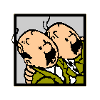 Si bien que son héros devient un véritable mythe dans cette deuxième moitié
du XX° siècle. Près de 300 millions d’albums vendus. Près de 100 millions
depuis 22 ans, depuis 1976, depuis le dernier album (Tintin chez les
Picaros). Tintin entre d’ailleurs à l’université. Il y a plusieurs
chaires de Tintinophilie, dont une à La Sorbonne. Les ethnologues, les sociologues
et autres spécialistes de la "psy" s’en sont emparés.
Si bien que son héros devient un véritable mythe dans cette deuxième moitié
du XX° siècle. Près de 300 millions d’albums vendus. Près de 100 millions
depuis 22 ans, depuis 1976, depuis le dernier album (Tintin chez les
Picaros). Tintin entre d’ailleurs à l’université. Il y a plusieurs
chaires de Tintinophilie, dont une à La Sorbonne. Les ethnologues, les sociologues
et autres spécialistes de la "psy" s’en sont emparés.  Hergé
trouve dans l’actualité du temps d’autres thèmes intéressants. La presse
fait alors état d’un trafic de fausse monnaie, et c’est l’Ile Noire
(1938). Tintin file en Ecosse, où un gorille hante un manoir isolé sur une
île rocheuse.
Hergé
trouve dans l’actualité du temps d’autres thèmes intéressants. La presse
fait alors état d’un trafic de fausse monnaie, et c’est l’Ile Noire
(1938). Tintin file en Ecosse, où un gorille hante un manoir isolé sur une
île rocheuse.